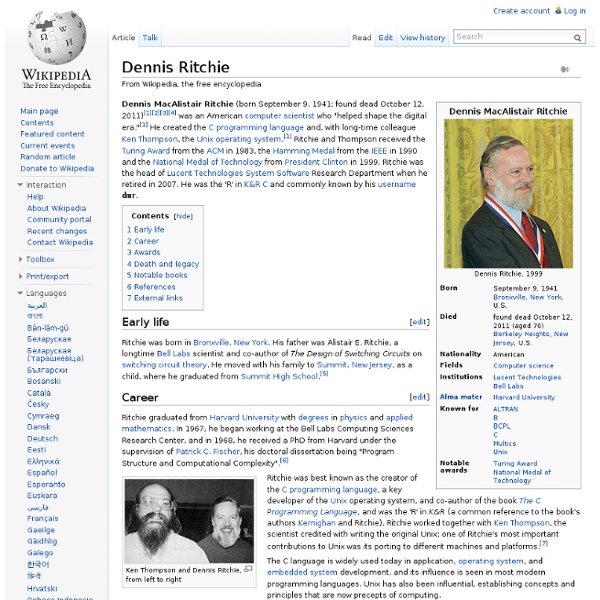Tim Berners-Lee
Sir Timothy John "Tim" Berners-Lee, OM, KBE, FRS, FREng, FRSA, DFBCS (born 8 June 1955),[1] also known as TimBL, is an English computer scientist, best known as the inventor of the World Wide Web. He made a proposal for an information management system in March 1989,[2] and he implemented the first successful communication between a Hypertext Transfer Protocol (HTTP) client and server via the Internet sometime around mid-November of that same year.[3][4][5][6][7] Berners-Lee is the director of the World Wide Web Consortium (W3C), which oversees the Web's continued development. He is also the founder of the World Wide Web Foundation, and is a senior researcher and holder of the Founders Chair at the MIT Computer Science and Artificial Intelligence Laboratory (CSAIL).[8] He is a director of the Web Science Research Initiative (WSRI),[9] and a member of the advisory board of the MIT Center for Collective Intelligence.[10][11] Early life Career Current work Awards and honours Personal life
Elon Musk
Elon Musk (/ˈiːlɒn ˈmʌsk/; born 28 June 1971) is a South African-born Canadian-American business magnate, investor and inventor.[5][6] He is currently the CEO & CTO of SpaceX and CEO & Chief Product Architect of Tesla Motors.[7] He was an early investor of multiple companies, most notably SpaceX, PayPal, and Tesla Motors.[8][9] Early life and education[edit] Musk was born in Pretoria, South Africa in 1971, to a Canadian mother and a South African-born British father.[10][11][12] Elon taught himself computer programming and at age 12 sold the computer code for a video game called Blastar for $500.[13] Career[edit] Zip2[edit] Musk started Zip2, a web software company, with his brother, Kimbal Musk. X.com and PayPal[edit] Elon Musk strongly favored the PayPal brand over the X brand. SpaceX[edit] Musk and President Barack Obama at the Falcon 9 launch site in 2010 In seven years, SpaceX designed the family of Falcon launch vehicles and the Dragon multi-purpose spacecraft from the ground up.
Jonah Lehrer
Jonah Richard Lehrer[1][2] (born June 25, 1981) is an American author, journalist, blogger, and speaker who writes on the topics of psychology, neuroscience, and the relationship between science and the humanities. He has published three books, two of which, Imagine and How We Decide, were withdrawn from the market by publishers after it became known that Lehrer had fabricated quotations. This led to his resignation from his staff position at The New Yorker following disclosures that he had recycled earlier work of his own for the magazine. A later investigation at Wired.com, where he had previously worked, found instances of recycled content and plagiarism. He was fired from that position as a result of the investigation. Personal life[edit] Lehrer owns the historic Shulman House in Los Angeles, California.[9][10][11] He is married to Sarah Liebowitz, who worked as a journalist, and the couple has one child.[3] Books[edit] Controversy and criticism[edit] Writing[edit] Reemergence[edit]
Bio
Bio in brief Vivek Wadhwa is a Fellow at Arthur & Toni Rembe Rock Center for Corporate Governance, Stanford University; Director of Research at the Center for Entrepreneurship and Research Commercialization at the Pratt School of Engineering, Duke University; and Distinguished Fellow at Singularity University. He is author of ”The Immigrant Exodus: Why America Is Losing the Global Race to Capture Entrepreneurial Talent”–which was named by The Economist as a Book of the Year of 2012. He was named by Foreign Policy Magazine as Top 100 Global Thinker in 2012. In 2013, TIME Magazine listed him as one of The 40 Most Influential Minds in Tech. Wadhwa oversees research at Singularity University, which educates a select group of leaders about the exponentially growing technologies that are soon going to change our world. Bio at length As a researcher, Wadhwa has studied the impact of globalization on U.S. competitiveness and remedies for the U.S. to keep its edge.
Ray Kurzweil
Raymond "Ray" Kurzweil (/ˈkɜrzwaɪl/ KURZ-wyl; born February 12, 1948) is an American author, computer scientist, inventor, futurist, and is a director of engineering at Google. Aside from futurology, he is involved in fields such as optical character recognition (OCR), text-to-speech synthesis, speech recognition technology, and electronic keyboard instruments. He has written books on health, artificial intelligence (AI), transhumanism, the technological singularity, and futurism. Kurzweil is a public advocate for the futurist and transhumanist movements, as has been displayed in his vast collection of public talks, wherein he has shared his primarily optimistic outlooks on life extension technologies and the future of nanotechnology, robotics, and biotechnology. Life, inventions, and business career[edit] Early life[edit] Ray Kurzweil grew up in the New York City borough of Queens. Kurzweil attended Martin Van Buren High School. Mid-life[edit] Later life[edit] Personal life[edit]
Laura Khalil
Terminals are basic, kinda ugly and wonderfully utilitarian. If you’ve ever thought about “tricking out” your terminal, there’s only so much you can do from the terminal application preferences pane. Changing the background and you can go all black window on green text, “super1337haxor living in the Matrix” style, but that’s as exciting as it gets. Taking a few more steps, you can transform your terminal into a snazzy window, with awesome colors and welcoming ASCII art. This tutorial is aimed at Mac users that have Homebrew installed. Here’s how to go from dull to dazzling in your terminal window: 1. Once this has installed, in the terminal, type:fortune Keep running it and see all the awesome fortunes that you’ll get! 2. From the terminal, run this command:brew install lolcat Once lolcat has installed, try runningfortune | lolcat Pretty cool, huh! Let’s take it a step further — ASCII ART!! Sidenote: This stuff is amazing. First, pick out the ASCII image you like. That’s right, people. ls -a



